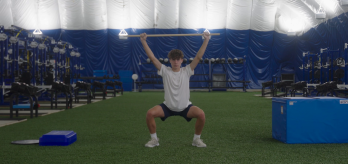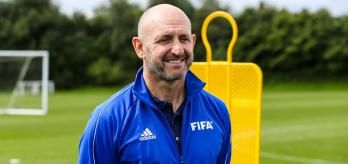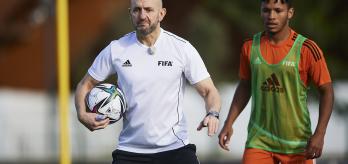As mentioned in the introduction to this series, athleticism training should complement football development, rather than interfering with it. A training approach that overemphasises physical elements, e.g. involving strenuous non-functional sessions prior to football training, or physical activity during a session that eats too much into precious time to be spent on technical-tactical elements, means that energy and time is expended to the detriment of the football aspect, which can prove to be counterproductive. Furthermore, adding unnecessary or unproductive low-value physical loads to an already demanding training schedule can have adverse effects.
In the modern game, players are required to possess outstanding athleticism and should ideally boast attributes similar to those of a cheetah: agility, mobility, explosivity, speed and strength. Although these cheetah-like qualities are developed naturally on the pitch, there is a clear need for players, especially those at youth level, to be exposed to structured non-football training to enable them to build the solid foundations required to fulfil their potential. Training time is precious, with every single second on a player’s technical development journey counting. As a result, there must be a clear rationale behind non-football training, which has to be highly efficient and have transferable functionality to the pitch. The overriding objective of the training methodology is to add value without sacrificing anything. This requires a modern, smart approach that seamlessly incorporates functional athleticism into the football programme in a complementary, compact and highly productive manner.
Smart training involves the assessment of current practices and requires the following questions to be asked: Is the adopted methodology of the highest possible value? Why, how and when is it implemented? All of these points need to be evaluated, as does the potential impact that the methodology has on individual football sessions, the training week and overall player development. In a drive to achieve efficiency, the main objective is to ensure that none of the exercises that make up the programme are insignificant or of low value. One-dimensional exercises that fail to develop football-specific athleticism have no place in the programme; they only serve to extend the duration of a training session and increase fatigue. When it comes to improving on-field attributes, the most relevant physical activities are those that help players to progressively develop excellent coordination and dynamism.
The smart approach to training involves no low-value, inefficient exercises and comprises high-value exercises that develop the functional attributes of athleticism: explosivity, mobility, stability and strength. Exercises that demand a very high level of coordination target a specific attribute while also requiring a significant contribution from other key functional qualities. For instance, strength exercises that demand a high degree of stability and mobility are considered to be of high value, as are mobility exercises that require significant strength and stability. The objective is to organise this high-value content into three training themes: dynamic mobility, strength and explosivity.
Another key facet of smart training is schedule efficiency and effectiveness, with the goal being to maximise gains without compromising technical objectives. In terms of developing pre-training athleticism, instead of implementing time-consuming, low-value sessions that sap players’ energy and result in undue fatigue, the key is to prioritise ultra-compact sessions of under 15 minutes featuring microdose loads that activate and potentiate players to benefit the quality of the football session that follows. The focus should be on synergising athleticism training with the theme of the subsequent football training, e.g. a short microdose load of high-value, lower-body or core strength exercises implemented prior to a football session on 1v1 duels or similar actions involving explosive directional changes such as those required when applying a press. This synergy between athleticism and football continues through the implementation of microdoses of high-quality, explosive exercises during the first stages of a football training session in which high-speed and explosive actions, e.g. runs in behind, counter-attacking or high lines, are the focus of the session.
In terms of post-training athleticism work, the focus is on development and not on activation. The goal is to carry out at least one compact session of under 30 minutes per week that focuses on the targeted attributes. A flexible, pragmatic approach is needed to incorporate this requirement into the overall weekly training load at the most optimal and effective times, e.g. scheduling core or lower-body strength development sessions after a low-intensity football session or during a recovery day is optimal, as is undertaking those same sessions after a medium- or high-intensity football session, provided that the following day is a recovery or very light-intensity day. The goalposts often move, which explains the need for a pragmatic approach in which adjustments are made to cater for changing circumstances.
Smart training: guidelines
These guidelines outline how to design and structure athletic development within a smart training framework that maximises efficiency, relevance and individual impact.
- Evaluation of current practice: remove any low-value/one-dimensional exercises and consider why, how and when exercises are implemented
- Focus: target key athleticism attributes – organise content into four main training themes: explosivity, mobility, stability and strength
- Selection of exercises: ensure exercises are high-value/multi-dimensional
- Customisation: adapt exercises to individual needs and abilities
- Regular exposure: complete at least one activation session and one development session per week for targeted attributes
- Mobility exposure: perform daily pre-training activation (five to ten minutes) and up to two weekly development sessions of under 20 minutes (one can be completed independently)
- Pre-training: schedule exercises with ultra-compact loads (microdoses of under 15 minutes), with a focus on football-specific activation
- Post-training: schedule exercises with compact loads of under 30 minutes, with a focus on development and optimal implementation (i.e. after light-intensity training)
As a part of this series, we share a simple, practical start-up guide to compact sessions. The majority of the exercises featured in each area involve bodyweight loading. All of the exercises are high-value, accessible and straightforward, and they require minimal equipment.
In the next article in this series, we will discuss the foundation of athletic expression: dynamic mobility, and explore its significance in the development of youth players. We will also share some simple foundational exercises that can be performed as part of a functional movement warm-up (pre-training) and a developmental mobility (post-training).

















